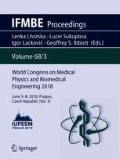Abstract
Developmental hip dysplasia (DHD) is frequently encountered in the pediatric orthopedic practice. DHD is characterized by dislocation of the femoral head in the acetabulum. In Brazil are diagnosed three times more cases than the world average (5–8 cases for 1,000 births). The lack of treatment leads to long-term morbidity, abnormal gait, chronic pain and arthritis. Early detection and treatment with a Pavlik harness results in improved outcomes. After 6 months of age, closed or open reduction with spica casting is required for 4 months to treat a persistent hip dislocation. Plaster is used for orthopedic immobilization due the low cost, moldability and good mechanical resistance. However, there are several risks and complications due to the use of spica cast in DHD treatment: Skin problems due to lack of adequate hygiene (itching, ulceration, dermatitis and infection), formation of pressure areas, plaster fracture (11% of cases) and fever. Digitization techniques have been explored for production of customized hip abduction brace by additive manufacturing. However, it is not possible to keep a child standing still to perform 3D scanning of the hip and legs region. The goal of this research was to develop an alternative approach for acquisition of the external geometry of the infant to create 3D model of an abduction brace. The parameterization technique created includes: The creation of a virtual 3D model of a child’s body using the MakeHuman software; Articulation of the hip region of the model to the position required in the treatment of DHD with the Blender software; Definition of the parameters required for the modeling of a hip abduction brace. A DHD pediatric orthopaedist approved the methodology created. Innovations in the area of assitive technology can bring many benefits to the user in the process of rehabilitation.
Access this chapter
Tax calculation will be finalised at checkout
Purchases are for personal use only
References
Campion JC, Benson MK. Developmental dysplasia of the hip. Surgery (Oxford), 2007;25(4):176–180.
Wilkinson AG, et al. The efficacy of Pavlik harness, the craig splint and the von Rosen splint in the management of neonatal dysplasia of the hip. JBone & Joint Surgery. 2002;84(5):716–719.
Hedequist D, et al. Use of an abduction brace for developmental dysplasia of the hip after failure of Pavlik harness use. Journal of Pediatric Orthopedics. 2003;23(2):175–177.
Ibrahim DA, et al. Abduction bracing after Pavlik harness failure. JPediatric Orthop. 2013;33(5):536.
Uras I, et al. The efficacy of semirigid hip orthosis in the delayed treatment of developmental dysplasia of the hip. Journal of Pediatric Orthopaedics B. 2014, 23(4):339–342.
Dyskin E, Ferrick M. Semirigid abduction bracing is effective treatment of reducible developmental dysplastic hips after failure of Pavlik harness. Annals of Orthopedics & Rheumatology. 2015;3(2):1045.
Wahlen R, Zambelli P. Treatment of the developmental dysplasia of the hip with an abduction brace in children up to 6 months old. Advances in orthopedics. 2015:1–6.
Toledo I, et al. Metodologia para produção de órteses por meio de fotogrametria, modelagem 3D e manufatura aditiva. XVII Congresso Brasileiro de Biomecânica CBB e I Encontro Latino Americano de Biomecânica, 2017, Porto Alegre. p. 564–465.
Mavroidis C et al. Patient specific ankle-foot orthoses using rapid prototyping. Journal of Neuroengineering and Rehabilitation. 2011;8(1):1–11.
Jumani MS, et al. Fused deposition modelling technique (FDM) for fabrication of custom-made foot orthoses: a cost and benefit analysis. Scientific International (Lahore). 2014;26(5):2571–2576.
Paterson AMJ, Bibb RJ, Campbell RI. A review of existing anatomical data capture methods to support the mass customisation of wrist splints. Virtual and Physical Prototyping. 2010;5(4):201–207.
Paterson A. Digitisation of the splinting process: exploration and evaluation of computer aided design approach to support additive manufacture [thesis]. Leicestershire: Loughborough University; 2013.
Paterson AM, Donnisson E. Computer-aided design to support fabrication of wrist splints using 3D printing: A feasibility study. Hand Therapy. 2014;19(4):102–103.
Paterson AM et al. Comparing additive manufacturing technologies for customised wrist splints. Rapid Prototyping Journal. 2015; 21(3):230–3.
Cano APD. Parametrização e produção de órtese termomoldável para imobilização de punho produzida por manufatura aditiva. 102p. Trabalho de Conclusão de Curso de Engenharia Biomédica (TCC) - Universidade Federal de São Paulo. 2017.
Meidanshahy T. Feasibility of using 3D printing in the manufacture of orthotics componentry. Diss. Flinders University, Adelaide, Australia 2014.
Munhoz R, Moraes CADC, Tanaka H, Kunkel ME. A digital approach for design and fabrication by rapid prototyping of orthosis developmental dysplasia of the hip. Research on Biom Eng. 2016;32(1),63–73.
Author information
Authors and Affiliations
Corresponding author
Editor information
Editors and Affiliations
Rights and permissions
Copyright information
© 2019 Springer Nature Singapore Pte Ltd.
About this paper
Cite this paper
Santos, N.A., Artioli, B.O., Goiano, E., Gonçalves, M., Kunkel, M.E. (2019). A Parametrization Approach for 3D Modeling of an Innovative Abduction Brace for Treatment of Developmental Hip Dysplasia. In: Lhotska, L., Sukupova, L., Lacković, I., Ibbott, G. (eds) World Congress on Medical Physics and Biomedical Engineering 2018. IFMBE Proceedings, vol 68/3. Springer, Singapore. https://doi.org/10.1007/978-981-10-9023-3_41
Download citation
DOI: https://doi.org/10.1007/978-981-10-9023-3_41
Published:
Publisher Name: Springer, Singapore
Print ISBN: 978-981-10-9022-6
Online ISBN: 978-981-10-9023-3
eBook Packages: EngineeringEngineering (R0)

